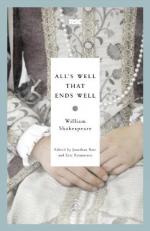|
This section contains 10,188 words (approx. 34 pages at 300 words per page) |

|
SOURCE: “The Making of Virgins and Mothers: Sexual Signs, Substitute Scenes, and Doubled Presences in All's Well That Ends Well,” in Philological Quarterly, Vol. 66, No. 1, Winter, 1987, pp. 47-71.
In the following essay, Hodgdon examines the gender theme on a structural level, revealing how Shakespeare's use of the various instances of doubling and substitution—most notably in the bed-trick scene—help to bring about the marital compromises that conclude the action of the play.
In All's Well That Ends Well, Helena stands, much like As You Like It's Rosalind, at the center of the internal drama as well as the critical drama—that is, its critical controversies concerning meaning and language.1 Both plays share significant story elements; both are fictions of an ordinary woman who becomes extraordinary. Both Rosalind and Helena disguise their sexuality—the one by assuming a mask which permits her to explore male as well...
|
This section contains 10,188 words (approx. 34 pages at 300 words per page) |

|


